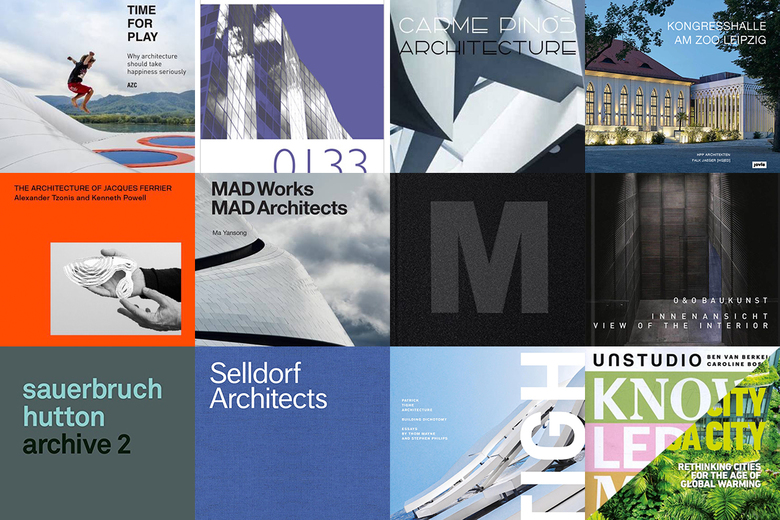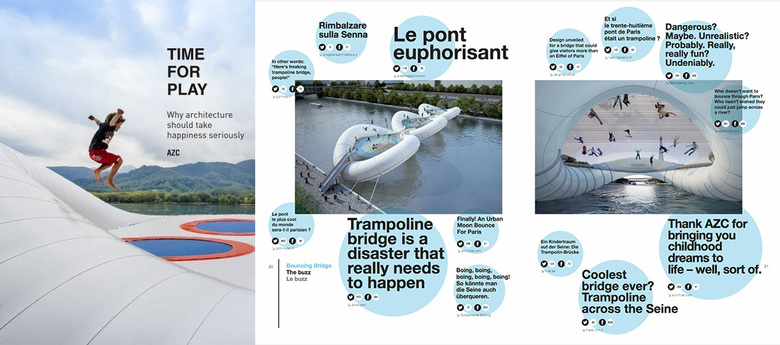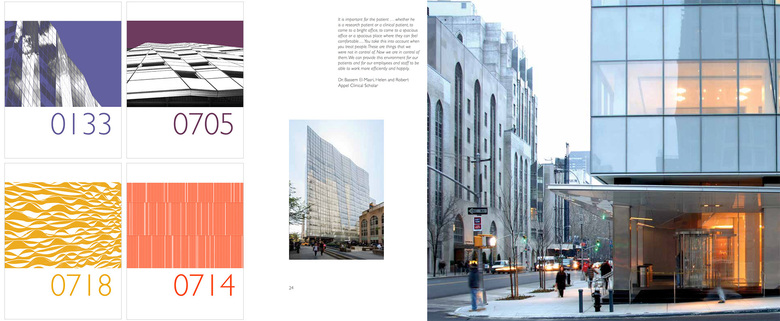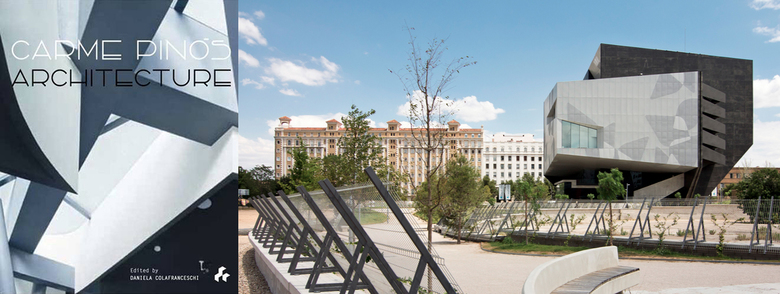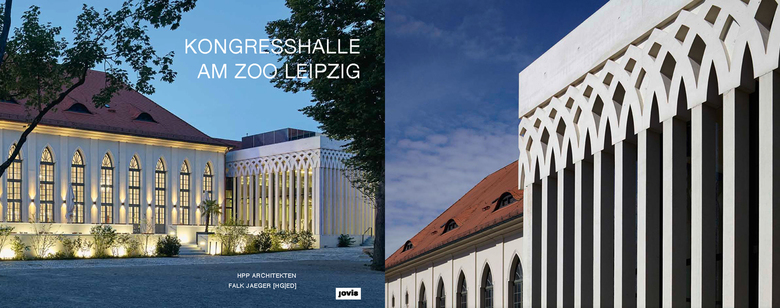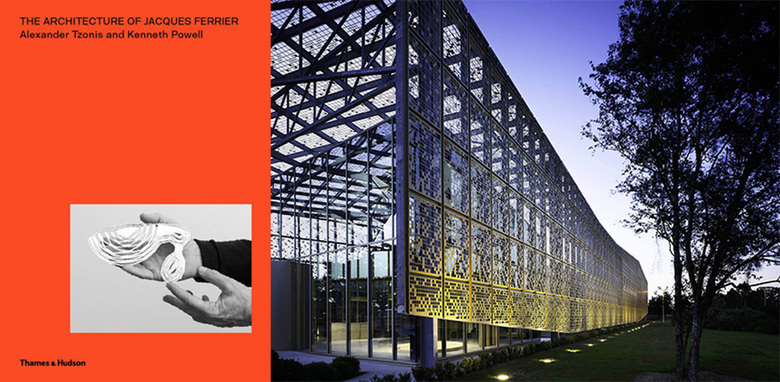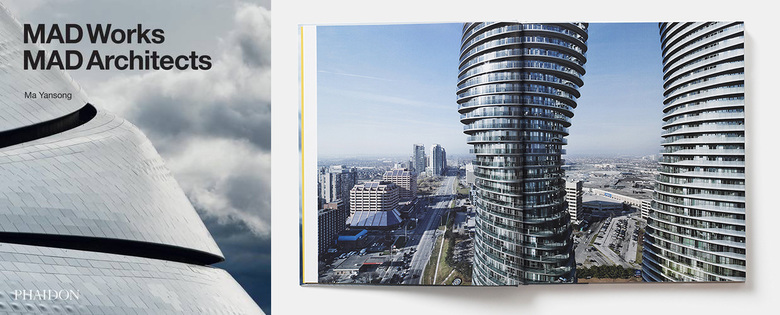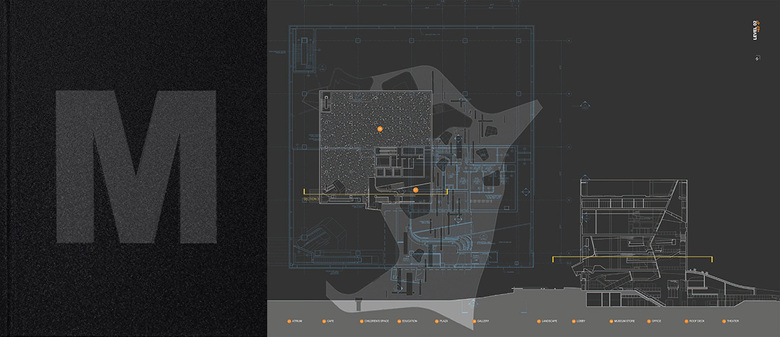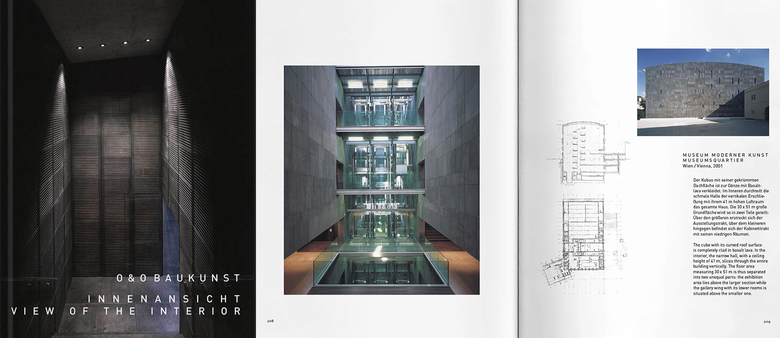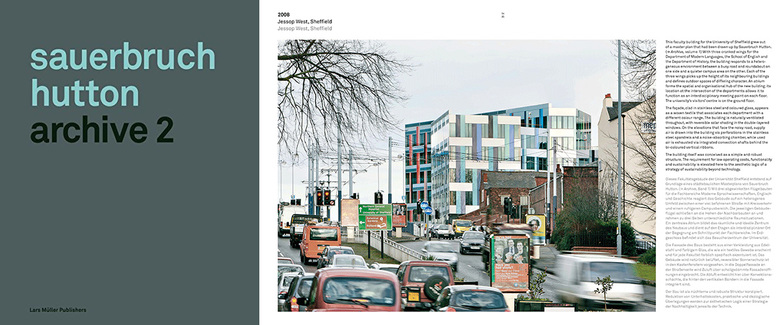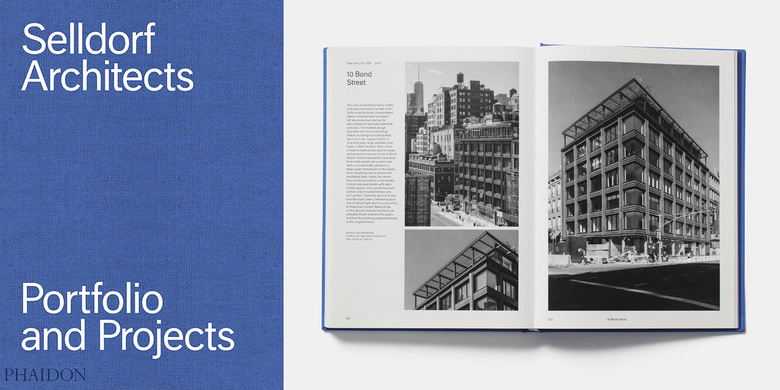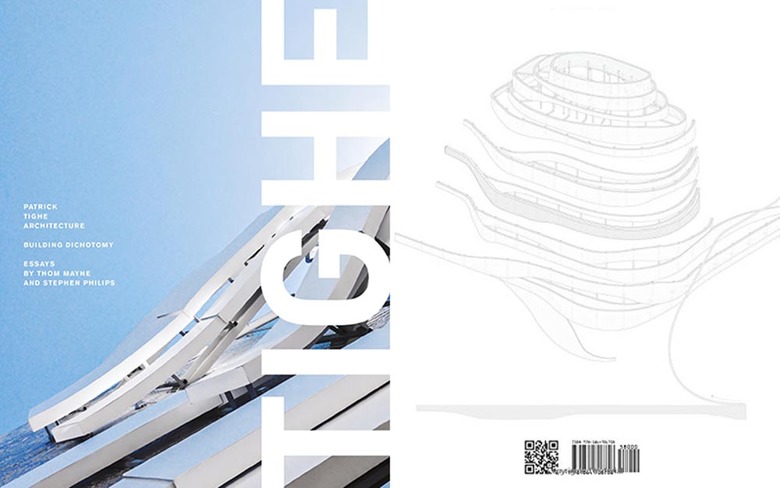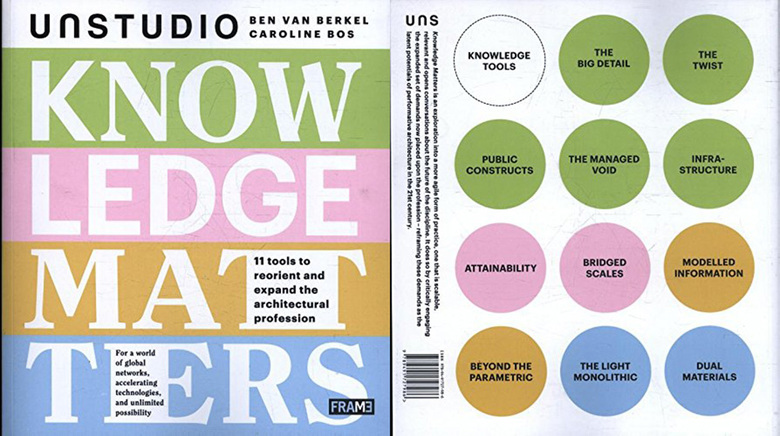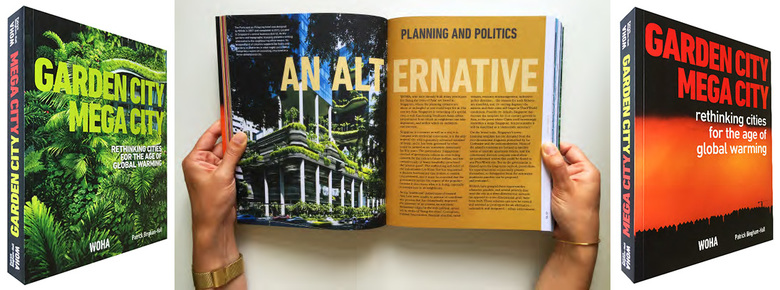2016 Monograph Roundup
John Hill
2. December 2016
As the year draws to a close we're presenting a selection of monographs on World-Architects member firms. Like last year's list, this baker's dozen illustrates that the architectural monograph is alive and well.
Atelier Zündel Cristea: "Time for Play: Why architecture should take happiness seriously" (Actar)
Atelier Zündel Cristea
Time for Play: Why Architecture should take Happiness Seriously
Actar
From the publisher:
Over the last 15 years AZC’s architectural work has developed through a diverse range of experiences. This book, Time for Play, presents exhibition pavilions, temporary installations, and ideas competitions – a mix of built and un-built projects.
"Today’s situation promotes innovation, supports creativity and enriches projects, calling on our intelligence. We are forced to take a new look at practices and uses, to consider different ways of doing things, to think about the humanity of a place; and all this when we still find it so hard to understand community needs, and even more so to keep up with changing society. Faced with a changing world, they propose solutions that are novel in their shape, use, cost and temporality. This project is realistic and realisable. The architects put their intelligence and skill not into regurgitating conventional solutions but into inventing new ones. They have left behind the stagnant reproduction of the city and shapes of the 19th century, repetition of a past time, and moved on to building in response to our times. Is this modernity? Does this project mark a new era, as did Paris Plage in 2002, or the subsequent shifting developments along the Left Bank of the Seine?" Jean-Pierre Charbonneau – 2015
Ennead Architects: "Ennead Profile Series 7 - Boxset" (ORO Editions)
Ennead Architects
Ennead Profile Series 7 - Boxset
ORO Editions
From the publisher:
Each book begins with this statement: This is one in a series of books, each of which tells the story of a single building. It is our hope that as these books accumulate alongside our body of work, they, in their aggregate, will form a profile of our design intentions. Acting as a “profile” of a building as well as contributing to the “profile” of Ennead Architects, each book employs initial program studies, schematic sketches, early two- and three-dimensional study models, construction shots, final photography and a personal statement by the designer to present an intimate, insider’s view of the creative process. A supplementary piece written by a critic, historian or client or a “found” text that relates to the designer’s aspirations or building’s program, site, function is typically included. The photographic narrative combines the precision and technical virtuosity of classic architectural photography with more lyrical and personal interpretations of the building, its context and the people who use it.
Estudio Carme Pinós: "Carme Pinós: Architecture" (Artifice Books on Architecture)
Estudio Carme Pinós
Carme Pinós: Architecture
Artifice Books on Architecture
From the publisher:
Not only a complete monograph of Carme Pinós’ architectural oeuvre, Carme Pinós: Architects traces the development of her practice over several decades via an in-depth investigation of the recurring themes and concerns that inform her work. Through studies of significant city projects and selected works, critical contributions from Peter Smithson, Daniela Colafranceschi, Rafael Moneo, Pedro Azura, Rafael Argullol, Francis Rambert, Juan Jose Lahuerta, Josep Quetglas, Magdelena Jaume and from Carme Pinós herself, come together to elucidate the motivations of one of the most compelling figures currently working in the contemporary architectural landscape. This publication journeys from Pinós early collaborations with Enric Miralles, characterised by an exploration of natural materials and forms that merge with their setting, to the evolution of her own emphatic works―a striking articulation of complex shapes and spaces that maintain a clear commitment to the quality of construction while perfectly integrating with the environment, whether natural or urban. Carme Pinós: Architects is a comprehensive overview of the atypical architectural expression of Carme Pinós’ truly unique and intriguing practice.
HPP Architects: "HPP Architects: Congress Hall at Leipzig Zoo" (JOVIS Verlag)
HPP Architects
HPP Architects: Congress Hall at Leipzig Zoo
JOVIS Verlag
From the publisher:
Built as a Gesellschaftshaus (“social functions building”) for the Leipzig Zoological Garden in 1900, this neo-romanesque structure with its tower was, after the war damage had been repaired, put to new use in 1946 as Leipzig’s Congress Hall. But neglect and years of being left empty did great damage to this stately building. From 2010 onward, it was thoroughly renovated, completely refurbished with new, modern technology, and expanded to include new halls. The magnificently restored Congress Center was finally inaugurated in 2015.
This book focuses on the rich history of the building and reports on the extensive renovation work and the careful restoration of its wonderful halls, including the unique Art Deco White Hall, by architects HPP Hentrich-Petschnigg & Partners. It also profiles the modern halls and the new components that add to the ensemble’s functionality, and make it a full-fledged convention center—one of the few in Europe with a historic ambience.
Jacques Ferrier Architecture: "The Architecture of Jacques Ferrier" (Thames & Hudson)
Jacques Ferrier Architecture
The Architecture of Jacques Ferrier
Thames & Hudson
From the publisher:
Influenced by the critic Rayner Banham, by the work of French architect/engineer Jean Prouvé, and by his early experience of working with Norman Foster, Jacques Ferrier has developed a highly individual approach to architecture that seeks to harness technology in order to create buildings and urban environments that fully engage with the practical and emotional needs of people. Central to Ferrier’s philosophy is the idea of the “Sensual City,” which aims to create buildings and cities that engage with the five senses—sound, smell, sight, touch, and taste—that compose human experience.
The Architecture of Jacques Ferrier is a review of this master architect’s work to date in Europe and Asia: from the French pavilion designed for the Shanghai World Expo 2010 and the Tabarly Sailing Museum in Brittany; to showcase headquarters for Hachette Livres and Piper-Heidsieck Champagne and the next-generation skyscraper, Hypergreen. The book features introductory texts by world-renowned architectural commentators Alexander Tzonis and Kenneth Powell, and a fascinating and insightful interview with Jacques Ferrier.
MAD Architects: "MAD Works: MAD Architects" (Phaidon)
MAD Architects
MAD Works: MAD Architects
Phaidon
From the publisher:
The skylines of modern China are punctuated by architecture that amazes, inspires, and awes. Many of these structures are the work of new, experimental practices like China-based MAD Architects. MAD Works not only documents the buildings of this group of avant-garde architects but also traces the development of their ideas through associated practice including art, research, and exhibition projects. Organized thematically, the book explores the underlying concepts of MAD Architects' work. MAD Works is illustrated with photographs, architectural drawings, and 3D visualizations to provide a thorough exploration of MAD Architect's international portfolio of completed works, unbuilt projects, and future ideas.
Morphosis: "Morphosis" (Equal Books)
Morphosis
Morphosis
Equal Books
From Hennessey + Ingalls:
This monograph is the first to document all of the built work by Morphosis, a Los Angeles-based firm headed by Thom Mayne and one of the most influential American architecture firms of the past twenty years. The firm's non-Cartesian forms; beautifully executed, sculptural models; and complex, computer-generated drawings helped to usher in a new era of architectural experimentation in the early 1980s that was also embraced by upcoming firms such as Eric Owen Moss, Rem Koolhaas, and Coop Himmelblau. Mayne himself became a highly desirable teacher, critic, and lecturer and continues to lecture and participate in conferences and competitions in Europe, South America, Israel, and Asia. Unlike previous volumes on Morphosis, which almost exclusively focus on drawings and model photographs, this book is comprised of bold, documentary-style color photographs of completed buildings, 35 in total, with carefully chosen plans and drawings added to punctuate the photos. Over the past few years Morphosis has garnered increasing attention and praise for its completed buildings. In The New York Times in December 2001, architecture critic Herbert Muschamp called the firm's Diamond Ranch High School in Pomona, California, "clearly the best American building of the year. Thom Maynes's integration of landscape, sociology, psychology and architectural form shows how to construct community out of diversity." Descriptive text and project lists are placed at the back of the book to maintain the book's emphasis on visual documentation of Morphosis's work and to dispel the misconception that the firm's theoretical work defies construction.
O & O Baukunst: "O & O Baukunst: View of the Interior: Buildings and Projects 1980–2015" (Verlag für moderne Kunst)
O & O Baukunst
O & O Baukunst: View of the Interior: Buildings and Projects 1980–2015
Verlag für moderne Kunst
From the publisher:
The oeuvre of the architecture practice O&O Baukunst looked at from a “different“ perspective: an impressive cross-section of interiors of buildings and projects ranging from the 1980s to the present day is shown, offering unsuspected and unfamiliar insights.
Sauerbruch Hutton: "Sauerbruch Hutton: Archive 2" (Lars Müller Publishers)
Sauerbruch Hutton
Sauerbruch Hutton: Archive 2
Lars Müller Publishers
From the publisher:
Lars Mueller presents a second major monograph on Sauerbruch Hutton: Archive 2 follows on from the previous Archive that recorded the practice’s work from its inception in 1989 to 2006. Archive 2 includes detailed descriptions of 70 works from the period between 2006 and 2015 as well as 6 essays by the architects and a complete register of all projects.
The current compendium traces the development of the office’s architectural practice and thinking through a series of completed buildings, works in progress and projects that, as yet, remain unrealised. The book illuminates its strategies of sustainable design, its multiple interventions in the post-industrial cityscape and the unfolding of an architectural language full of sense and sensuality that reacts to its physical and social context, as well as to functional, technical, spatial and sculptural considerations.
The book reveals Sauerbruch and Hutton’s understanding of their profession as an ongoing process of research into presence and future, and is the only comprehensive documentation of their numerous works.
Selldorf Architects: "Selldorf Architects: Portfolio and Projects" (Phaidon)
Selldorf Architects
Selldorf Architects: Portfolio and Projects
Phaidon
From the publisher:
Founding principal Annabelle Selldorf was born in Cologne, Germany and educated at the Pratt Institute and Syracuse University. The firm launched into international prominence with the opening of New York's Neue Galerie in 2001. Since, Selldorf Architects has become known for galleries, cultural projects, and as well as private homes. More recently, the firm has made its mark with Sims Municipal Recycling in Brooklyn in 2013. The design and construction won an Award for Excellence in Design from the Public Design Commission. In 2014, Selldorf Architects received the commission to build the expansion of the Museum of Contemporary Art in San Diego.
This book begins with an extensive conversation between Tom Eccles and Annabelle Selldorf, as well as an essay by architecture critic Ian Volner. A newly-shot, full color portfolio by renowned photographer Todd Eberle is complimented by an in-depth look at the story behind 30 selected projects, including architectural plans and sketches.
Tighe Architecture: "Patrick Tighe Architecture: Building Dichotomy" (Images Publishing)
Tighe Architecture
Patrick Tighe Architecture: Building Dichotomy
Images Publishing
From the publisher:
This beautifully designed and illustrated monograph sets out Patrick Tighe’s innovative, diverse and wide-ranging collection of contemporary work towards the post-digital, showing the reader a hyper-detailed analytical investigation of digital forms and their practices.
It sets out how his architecture has brought a return to the real in an attempt to rethink the language and practice of architecture. The book’s many inspiring and intricate drawings render clear the ideas that show the palpable energy and momentum that exists in this practice. In every instance, this firm embraces dichotomy, mining its potential to produce a more vital and consequential architecture.
The book’s stunning imagery and nuanced narratives tell the story of Tighe’s architecture across 35 projects spanning across the globe, to help establish how his work draws from and builds upon existing polarities to find resolution, and how tensions yield a more dynamic architecture. The work is multiple and varied: from the small-scale residential to the urban scale, from the United States to Europe to China to North Africa, from high-end villas for royalty to art installations to social housing projects.
This compelling collection of work follows the following five key themes: CRAFT (from the manufactured to the technological); MATERIAL (from the natural to the synthetic); EXPERIENCE (from the actual to the perceptual); GEOMETRY (from the simple to the complex); and METHOD (from the analog to the digital). This distinguished monograph also includes an incisive introduction by Patrick Tighe and is augmented by two essays by Thom Mayne and Stephen Phillips, who also provide clarity and insightful discourse on how Tighe’s work is continuously in transition and evolving, and how he’s rethinking and engaging in a discourse to defamiliarize the familiar.
UNStudio: "Knowledge Matters" (Frame Publishers)
UNStudio
Knowledge Matters
Frame Publishers
From the publisher:
The architectural profession has expanded in recent years, not just in terms of cultural influences, but equally with respect to scientific advances. The inventive economy has also led to new lifestyle choices and a new role for the architect and architectural practice. We talk of an architecture that is either pre-crisis or post-crisis, the latter resulting in a call for responsible architecture (affordable, sustainable, attainable and healthy).
These changes have led to a reorganisation of UNStudio’s practice; the introduction of Knowledge Platforms and the development from a network to a knowledge practice. Now compiled into an inspiring publication, Knowledge Matters recasts architecture as the conduit through which the passive reception of knowledge is reimagined as the active production of it. It is an exploration into a more agile form of practice, one that is scalable, relevant and opens conversations about the future of the discipline.
WOHA: "Garden City Mega City: Rethinking Cities for the Age of Global Warming" (Pesaro Publishing)
WOHA
Garden City Mega City: Rethinking Cities for the Age of Global Warming
Pesaro Publishing
From the publisher:
Garden City Mega City is a proposal to save our cities, in order to save our planet. The growth of mega cities is destroying our planet, and it concerns all of us. City planning and construction is no longer the preserve of specialists, as the biggest decisions must be made by society at large.
This Tête Beche book presents the Mega City set of problems, and the second half provides a Garden City set of solutions. Garden City Mega City illustrates the depressing realities of life in the mega cities, and documents the ill-advised planning decisions that created such blighted environments.
But Garden City Mega City proposes an escape from what appears to be an inevitable fate, one of terminal dysfunction. Mega cities have been re-imagined as 21st century garden cities - dense and vertical, yet sociable and sustainable. The fundamental strategies and principles of these new garden cities are explained and illustrated, as are WOHA’s large-scale prototypes - many already built.
